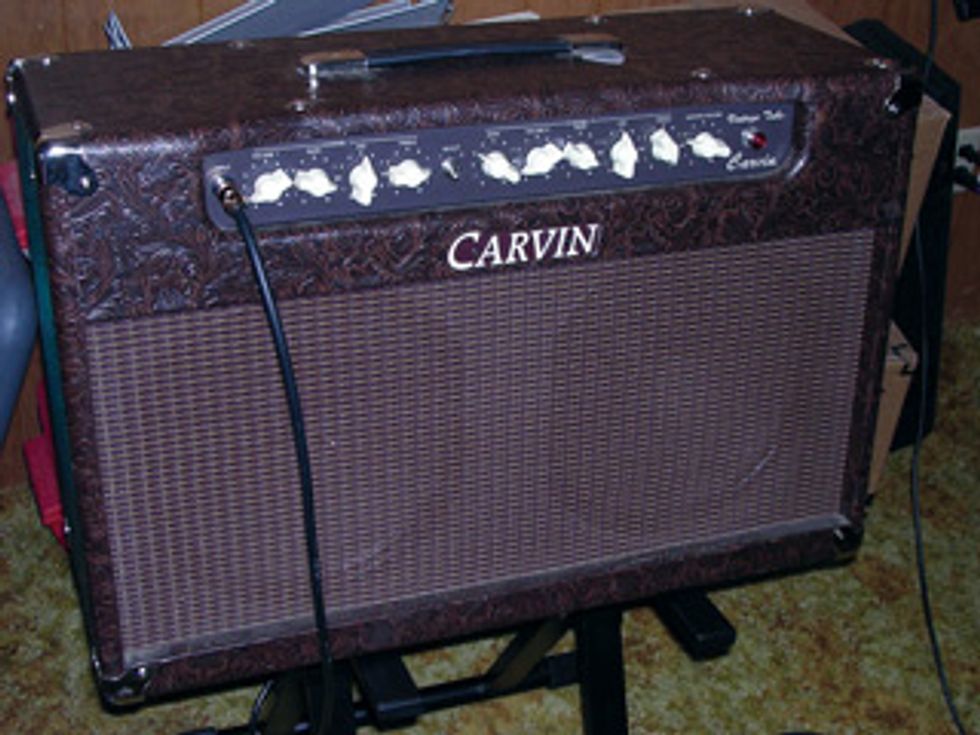
This Carvin Belair sports a quartet of EL84s and pumps out 50 watts of tube tone through a pair of Celestion Vintage 30s.
In response to an email Joseph Centeno sent me about his Carvin Belair 212, last month we began exploring a series of mods for this EL84-equipped combo [“Reducing Output in a Carvin Belair 212,” September 2012]. Seeking to lower the level of this non-master volume combo, Centeno had come across a handful of mods for this amp online and wanted my opinion on them. (You can download these mods in PDF format at hasserl.com, a cool amp and mod-kit website run by Richard Hasse.)
Due to space considerations, I couldn’t address every modification Centeno inquired about, so we’ll finish the job now. If you missed Centeno’s original email and the first batch of mods, go to premierguitar.com and check them out. So far, we’ve covered clipping diodes, the tone stack, and cathode bypass caps. Now let’s dive into two more mods.
Master Presence Control. In designing this amp, Carvin chose to make the presence control active only when the amp is in its clean mode (channel 1) and not in “soak” mode (channel 2). This strikes me as odd for a couple of reasons. First, according to some Belair users, the presence control doesn’t do much to alter the clean channel’s sound, so why not leave the control active in both modes in the hope that it would be more beneficial to channel 2? Second, the way the presence control is disabled in channel 2 essentially leaves it in what would be a “minimum” setting. This offers no help for a channel that was already a bit dark and muddy. For these reasons, I’d highly recommend making the presence control active for both channels.
Here’s how to do this: In its stock configuration, the control’s wiper is connected to a relay. The relay electrically connects the wiper to the ground when channel 1 is engaged. When channel 2 is engaged, the wiper is electrically lifted from the ground, causing the control to become inoperative. The modification Centeno sent me removes the connection to the relay and connects the wiper directly to the ground, thereby leaving the presence control always operational.
I think this is a great idea, but I’d approach it differently. In the original mod, you cut one of the wires near the connector on the presence control circuit board, attach a new wire to the connector, and link the other end of that wire to the nearest ground lug. This will indeed make the presence control permanently active, but I’m concerned with the choice of ground connection. Seeing as how all grounds are not the same—that’s another topic entirely—I’d recommend against cutting the wire at the connector, but instead following it back to the circuit board, cutting it there, and then finding a suitable ground point in that area. This would put the ground connection closer to where it was originally grounded and may alleviate any unwanted issues, such as parasitic oscillation.
Phase Inverter Master Volume. Master volume circuits have been around for many years. Their function, of course, is to set the amp’s overall volume level after you’ve set the gain to your liking, but there are different ways to get the job done and they all sound different.
The suggested master volume mod for the Belair takes the post-phase inverter signal and varies the signal level being sent to the output stage. Because it is after the phase inverter, there are two discrete signals that need to be dealt with, each going to one half of the push-pull output stage. For that reason, this is the most complicated and parts-heavy master volume circuit to install. It is, however, a very “clean” master volume circuit that should not color the characteristics of the amp much, especially with regards to the rhythm channel.
I think this is a good mod, but it’s worth noting that the master is active in both channels and not just in the overdrive channel. That said, it actually might help Centeno with his need to “reduce output to allow for use in small rooms.” He may now be able to reduce the overall volume of the amp and increase the settings of the individual channels to get a bit more crunch at lower volume levels. This additional crunch will be coming from the preamp sections and not the output stage, as the signal levels are being reduced before they can send the output section into overdrive.
In my opinion, slamming the output tubes yields the best type of overdrive. If the goal is to push the output tubes harder, yet reduce the amp’s overall volume, there are a couple of other options to explore. One is an external attenuator, such as the THD Hot Plate, Tube Amp Doctor Silencer, and Rivera RockCrusher. The advantage here is that you can use an attenuator with any amp by simply inserting the device between the amp’s output jack and speakers. An attenuator lets you set the overall volume of the amp after the output stage, and this allows you to drive the output tubes into distortion.
Another quick, easy, and cost-effective option to reduce the Belair’s output level would be to replace its stock EL84 output tubes with EL844s. I quickly auditioned a pair of these in my EAST Club18 amp and they reduced the output by approximately 30 percent and saturated more quickly than the stock EL84s.
And speaking of tubes, Centeno had a question about altitude possibly affecting tube performance. Here’s what he wrote: “Does altitude have an effect on tubes? Most of the bars here are at about 5,000 feet, but we have some clients that have a bar at almost 10,000 feet.”
I don’t believe altitude will have an effect on tubes, since the bottle is pressurized and also since tubes were used for many years in aircraft navigation systems, which I’m pretty sure fly higher than 10,000 feet.
All right—we’ve had fun with the Carvin Belair. See you next month for more amp madness!
 Jeff Bober is one of
the godfathers of the
low-wattage amp revolution,
co-founded and was
the principal designer for
Budda Amplification. Jeff recently launched EAST
Amplification, and he can be reached at
pgampman@gmail.com.
Jeff Bober is one of
the godfathers of the
low-wattage amp revolution,
co-founded and was
the principal designer for
Budda Amplification. Jeff recently launched EAST
Amplification, and he can be reached at
pgampman@gmail.com.






![Rig Rundown: Russian Circles’ Mike Sullivan [2025]](https://www.premierguitar.com/media-library/youtube.jpg?id=62303631&width=1245&height=700&quality=70&coordinates=0%2C0%2C0%2C0)


























